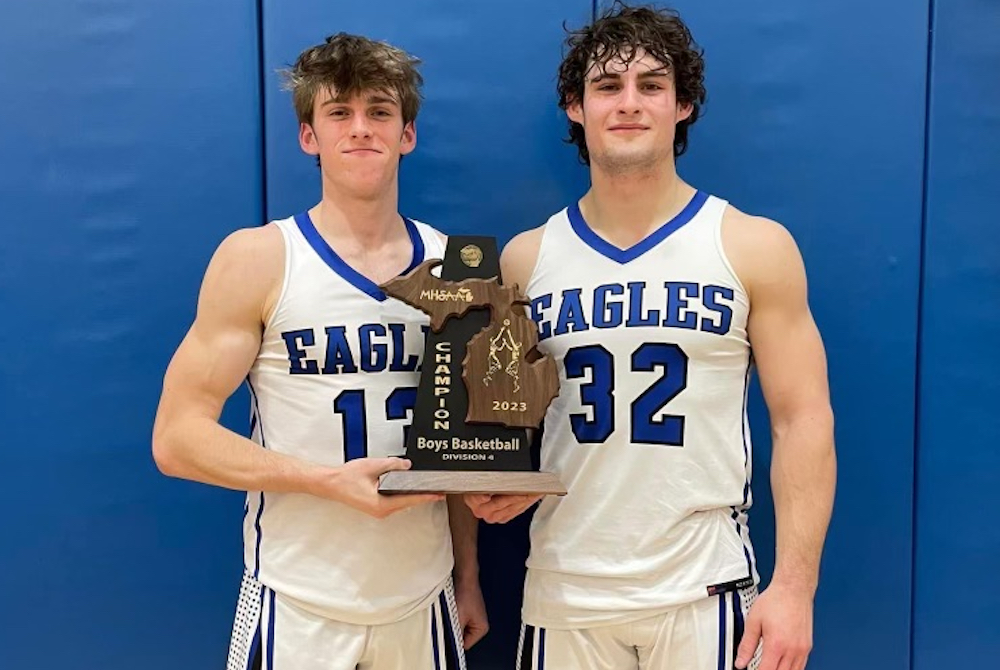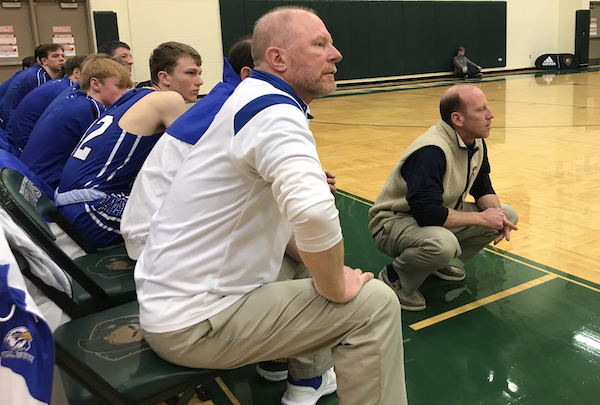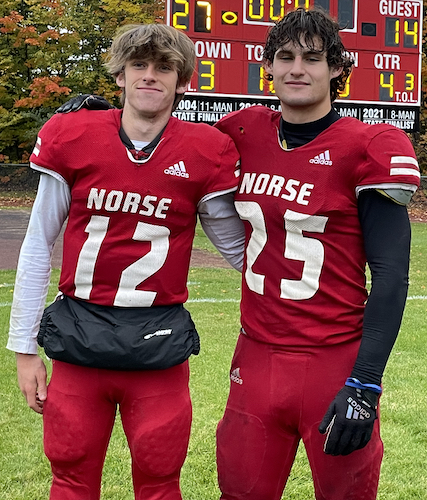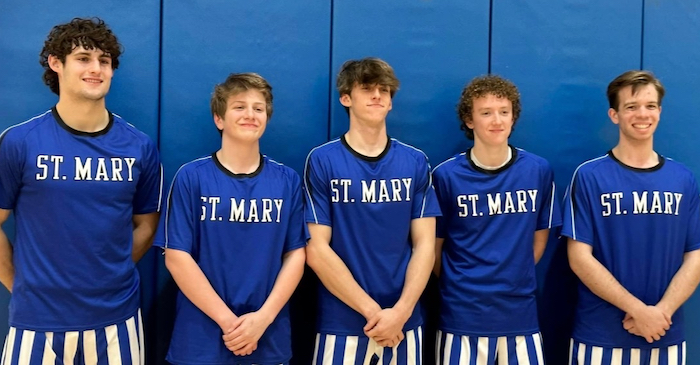
'22 Game' Lasts 2 Plays, Lives on
By
Ron Pesch
MHSAA historian
October 26, 2015
What would you do with 22 seconds to right a wrong?
In Michigan, the longest football game in high school sports history was played on September 23, 1977 when Detroit Southeastern defeated Detroit Northeastern 42-36 in nine overtimes.
But what is the shortest?
On the evening of Thursday, Nov. 5, 1953, Eaton County foes Bellevue and Vermontville squared off in a Tri-C Conference battle. It was a home contest for Vermontville, but without illumination at its field, the game was staged just west beneath the lights at Nashville High School in Barry County.
The dominant team in Tri-C play over the previous three years, Bellevue’s Broncos had posted three consecutive undefeated seasons from 1950 and 1952. However, graduation took its toll and with only five returning veterans in the fall of 1953, Bellevue lost its nonconference season opener to Homer. The Broncos had also dropped a pair of league contests, to Lake Odessa and Olivet, just prior to the Vermontville game, and entered with a 4-3 record.
Vermontville brought a 4-2 mark into the contest, and was in a four-way tie with Bellevue, Nashville and Lake Odessa for second in the conference.
The Broncos and Wildcats were evenly matched and played to a scoreless tie in the first half. Vermontville opened up a 6-0 lead on a 20-yard end sweep by the Wildcats’ quarterback Pete Benton in the third quarter, but entered the final minutes of the game trailing 12-6 thanks to a TD run by Bellevue’s Jim Smith and an early-fourth quarter scoring pass from Smith to Bob Babbitt.
Coach Dave McDowell’s Wildcats mounted a long final drive, and fans strapped in for a thrilling finish. Pushing deep into Bellevue territory, Vermontville faced a fourth down and eight from the 16-yard line with under a minute to play when Benton launched a desperation pass to the end zone.
The pass fell incomplete, but Bellevue was flagged for pass interference. Officials stepped off the penalty and awarded Vermontville the ball at the one-yard line, but the Wildcats’ plunge into the line fell an inch short on what was called a repeated fourth down play. Vermontville took possession and ran out the clock.
Following the game, Coach McDowell protested the ruling to officials, correctly stating that his team should have been awarded an automatic first down and goal from the 1-yard-line on the penalty, according to high school rules. Appealing the call, the situation was brought to the attention of the league, MHSAA executive director Charles Forsythe and the MHSAA athletic board.
On Wednesday, Nov. 11, the state athletic board agreed an error had been made, but did not order a replay. Instead, they noted three possible solutions:
- Result left as it was.
- Called a no contest.
- Replay it at the point of infraction.
The board moved a final decision back to the league. Because of the possible impact on the final conference standings, and eventually, the awarding of the league’s all-sports trophy, the Tri-C Conference opted to replay the contest from the point of infraction – the 1-yard line – with 22 seconds placed on the clock.
 The news of the league’s decision was blasted out by the news services nationwide, and immediately, the pending replay of a small town contest captured the imagination of reporters and sports fans across the United States.
The news of the league’s decision was blasted out by the news services nationwide, and immediately, the pending replay of a small town contest captured the imagination of reporters and sports fans across the United States.
“Shortest ‘Game’ in History?” read the headline in the Lexington, Kentucky Herald. From Biloxi, Mississippi, to Boston, Massachusetts, from Rockford, Illinois to Omaha, Nebraska and Seattle Washington, sports aficionados read the news about the error. Best of all, details flowed forth on the plan to replay critical seconds that might alter the result, fulfilling every fan’s dream.
So began the longest huddle in history.
“What would you do?” was the question on the lips of coaches and followers in barber shops and factories. Detroit Free Press writer George Puscas asked that very question to some of Michigan’s top coaches.
Detroit Lions coach Buddy Parker offered his advice to Vermontville’s coach McDowell.
“The other team will be expecting a run,” noted Parker, “so I would fake a run off tackle then throw a pass in the other direction – with three receivers downfield.”
Michigan State’s legendary Biggie Munn stated the obvious:
“Call a scoring play.”
University of Michigan head coach Bennie Oosterbaan was tied up preparing for the Wolverines’ upcoming contest with MSU, so instead U-M end coach Bill Orwig weighed in with a tongue-in-cheek recommendation:
“Take the time out.”
Earl “Dutch” Clark, in charge at the University of Detroit, suggested that McDowell diagram “two of the most unusual offensive formations … anything to confuse the defense. The first play should be a running play and if it didn’t work, take time out then try again.”
Wayne University’s coach Lou Zarza was the most specific of them all.
“On a goal line stand, the defense usually drifts toward the middle. So I would fake the ball to the right halfback on a slant, then send the fullback with the ball wide to the right, outflanking the defense. It’s a good goal line play on the T formation.”
Suggestions came from all over. A gentleman in Syracuse, New York, even penned a personal letter to McDowell with a sure-fire suggestion.
Three days after the 1953 prep season had officially ended, on the afternoon of Monday, Nov. 16, the same officiating crew and the Vermontville and Bellevue squads emerged and again travelled to Nashville to line up for what can arguably be called the shortest – or perhaps the longest – game in high school football history.
Reporters from Detroit, Grand Rapids, Lansing and Battle Creek converged on the city for 22 seconds of football. High school reporting legends Hal Schram of the Detroit Free Press, Bob Hoerner of the Lansing State Journal, George Maskin of the Detroit Times, Harry Stapler of the Detroit News and writers from the Associated Press and United Press International all descended upon mid-Michigan, “almost as if the Rose Bowl was to be played.”
“That game brought more publicity to coach Gordon Korstange’s 6-3 squad then his teams received for posting three consecutive unbeaten seasons in 1950, 1951 and 1952,” recalled 80-year old Burton H. Brooks, who was the only reporter who had covered the original contest, and one of many covering the replay. A graduate of Bellevue, he was a freshman at Michigan State at the time, earning money as a sports stringer for the Bellevue Gazette and Charlotte Republican Tribune.
Beneath sunny skies, “a crowd of over 500 fans and curiosity seekers, most of them attired in shirt sleeves, lined the field on both sides near the east end of the Nashville gridiron,” wrote Brooks, many years later. “At 5:00 the shrill blast of an official’s whistle split the air, announcing time for the game.”
Attendance was way up from the original contest, and in an unusual move for the time, Kalamazoo television station WKZO announced that they would send a crew to Nashville and then televise the game – (all 22 seconds of it!) – Tuesday evening. In addition, 10 newspaper photographers were on site to capture images from the game.
While the size of the crowd was up, turnout on the football squads had decreased. Vermontville dressed its full squad of 24 for the showdown, but kept out two regular tackles and his first-string quarterback, as all had been on the injured list at the end of the first clash.
Meanwhile, Bellevue brought only 14 players.
“Just our defensive unit and enough to run back the kickoff,” Korstange told the Lansing State Journal, prepared for a situation that could arise if Vermontville scored.
“Three of the defensive starters had decided to go deer hunting instead,” said Brooks discussing the shortened game, “so Bellevue needed to call up some kids for the game from the junior varsity squad.”
“Bellevue won its sixth game of the year, downing Vermontville in a sensational goal line stand in the famous ‘22’ Game” at Nashville last Monday,” wrote Brooks in the Bellevue Gazette. “Coach Dave McDowell’s Wildcats ran two plays against Bellevue, but couldn’t dent the solid Bronco defense. On the first play the Wildcats sent big Bob Steward up center, but he was driven back a yard by the entire center of the Bellevue line.”
 Following a timeout, the Green and White tried to sneak quarterback Pete Benton across the line to the left of center as the ball carrier on the second play, but the hole was quickly plugged by tackle Donald Rogers and guard Jerry Babbitt. Steward had been stopped by Bellevue guard Wayne Lesser. Dale Spotts, Bob Babbitt, Harold Messenger, Ralph Hales, Dick Moon, Jim Smith, Gordon Smith, and Ed Bessemer filled the other defensive spots and ensured the result of the first game went unchanged.
Following a timeout, the Green and White tried to sneak quarterback Pete Benton across the line to the left of center as the ball carrier on the second play, but the hole was quickly plugged by tackle Donald Rogers and guard Jerry Babbitt. Steward had been stopped by Bellevue guard Wayne Lesser. Dale Spotts, Bob Babbitt, Harold Messenger, Ralph Hales, Dick Moon, Jim Smith, Gordon Smith, and Ed Bessemer filled the other defensive spots and ensured the result of the first game went unchanged.
Once again, the wire services blasted their report from sea to shining sea.
“Officials Didn’t Rob Vermontville Team” screamed the headline in the Miami Daily News. Beneath an AP photo, residents of the Florida town were treated to a detailed account of the contest.
“Prep Grid Game Ends Same Way Following 11-Day Break” read the caption in the Dallas Morning News in football-crazed Texas.
“Replayed Grid Game Ends with the Same Result as Before,” read the headline in the Seattle, Washington, Daily Times.
As noted at the time, it certainly wasn’t the first, nor would it be the last, that a refereeing crew made a mistake in a game. Fans then, like now, were reminded officials are only human.
Bellevue ended the extended season in a tie for second with Lake Odessa, with 5-2 marks. For the first time in league history the Tri-C gridiron championship was awarded to Olivet, which, at 8-0, posted its first unbeaten season and, as it turned out, unseated Bellevue for the league’s 1953-54 all-sports trophy.
More than 60 years later, a forgotten showdown between high school football teams, played out before national attention in little Nashville, Michigan, still stands as one of the most entertaining and unusual sports moments in the history of America.
 Ron Pesch has taken an active role in researching the history of MHSAA events since 1985 and began writing for MHSAA Finals programs in 1986, adding additional features and "flashbacks" in 1992. He inherited the title of MHSAA historian from the late Dick Kishpaugh following the 1993-94 school year, and resides in Muskegon. Contact him at [email protected] with ideas for historical articles.
Ron Pesch has taken an active role in researching the history of MHSAA events since 1985 and began writing for MHSAA Finals programs in 1986, adding additional features and "flashbacks" in 1992. He inherited the title of MHSAA historian from the late Dick Kishpaugh following the 1993-94 school year, and resides in Muskegon. Contact him at [email protected] with ideas for historical articles.
PHOTOS: (Top and below) What's believed to be a Battle Creek Enquirer photo shows one of the goal line stands by the Bellevue defense against Vermontville. (Middle) The Lansing State Journal reported on the nationwide reporting of the "22-second game."

For Their Teams, For Each Other, St. Mary Seniors Team Up 2 More Times
By
Tom Spencer
Special for MHSAA.com
March 17, 2023
Shawn Bramer and Dylan Barnowski, as middle schoolers, attended the MHSAA Boys Basketball Finals every year.
 Last year, they nearly played in the Division 3 title game – falling in a Semifinal but almost making a dream come true for the then-juniors and their Lake Leelanau St. Mary coach, Matt Barnowski, also Dylan’s father.
Last year, they nearly played in the Division 3 title game – falling in a Semifinal but almost making a dream come true for the then-juniors and their Lake Leelanau St. Mary coach, Matt Barnowski, also Dylan’s father.
That dream began for some when the boys were coached by Matt as third graders, and they made serious strides last season. Before last winter, the last time the Eagles had won a Regional championship was 1950 – and no St. Mary boys basketball team had reached the Semifinals. Bramer and Dylan Barnowski – along with current seniors Jack Glynn, Drew Thompson and Nick Linguar – had high hopes of making more history this winter.
The dream ended Wednesday night with a Regional Final loss to Frankfort, which St. Mary had defeated 54-41 during the regular season. This time, the Eagles were faced with a large number of K-12 students succumbing to illness – with all five of its starters at least somewhat sick – as nearly a third of the school’s tiny enrollment was out of school the day after the loss to the Panthers.
But you won’t hear any of the players or coaches making excuses. They give all the credit to Frankfort, and they’re ready to move on. And many in the LSM family know reaching the Regional Finals this season and Breslin Center in 2022 had absolutely no probability had Bramer and Barnowski not made an iron-clad agreement last summer.
 The two friends vowed to help each other despite their personal, opposing challenges.
The two friends vowed to help each other despite their personal, opposing challenges.
Barnowski and Bramer, through LSM’s cooperative agreement with Suttons Bay, went 3-for-3 playing in 8-Player Division 1 Football Finals during their first three years of high school. But through last summer Barnowski, who quarterbacked the Norseman, had no interest in football.
Bramer, meanwhile, had been nursing a quad tendon injury since his sophomore football season and battling two bad knees but was thinking he could suffer though football and sit out the basketball season to recover. The all-state running back experienced training difficulties and even had his strength training severely hampered.
Football was king for Bramer, and he also loved basketball too. Basketball is number one to Barnowski. The longtime friends decided cut a deal to help each other — and their teammates — out.
“I was kind of on the edge,” said Bramer, who plays with braces on both knees. “After talking to each other, we both ended up just playing.
“I really shouldn’t be playing sports, but I couldn’t miss out playing with my friends,” he continued. “We just figured it was our last season so we might as well just do it.”
 Barnowski had been considering ending his football days immediately after the Norse fell short in their third-straight trip to the Finals, at Superior Dome in Marquette in Fall 2021. That loss was at the hands of Adrian Lenawee Christian 31-20.
Barnowski had been considering ending his football days immediately after the Norse fell short in their third-straight trip to the Finals, at Superior Dome in Marquette in Fall 2021. That loss was at the hands of Adrian Lenawee Christian 31-20.
The Norseman graduated most of their offensive and defense lines last spring and expected to be small in numbers. Until this fall, they had lost only one regular-season game on their way to three straight title game appearances. This year they finished 3-5.
The big linemen losses — Barnowski’s protection — was forcing him to weigh his injury risk against having a senior basketball season.
“We did it for each other,” Barnowski said. “I talked with Shawn, and we knew we had a big community behind us and it would be hard for them if we just quit.
“I knew we weren’t going to have the same powerhouse team we had,” he continued. “We weren’t very good this year, but we still had a blast.”
This week’s loss put an end to the possible Breslin championship finish, but it left the friends happy with the decision to play both sports. The Eagles finished 20-4.
Barnowski led St. Mary in scoring. He averaged better than 20 points a game with more than seven rebounds and five assists. Bramer averaged just under 15 points per game, and almost 10 rebounds.
The two big men each scored 11 in the season-ending loss. Thompson scored 14. This year’s senior-dominated team likely will be remembered for its basketball success for some time. Barnowski, Bramer and Glynn experienced only one loss in District play over their four seasons.
“It’s a really special groups of kids,” Coach Barnowski said. “These kids kind of transformed St. Mary’s basketball.
 “They’ve really built the program,” he continued. “It’s been a roller coaster ride.”
“They’ve really built the program,” he continued. “It’s been a roller coaster ride.”
Bramer and Dylan Barnowski also played baseball in the past for the Eagles, but that likely won’t happen this spring. Barnowski plans to golf, and Bramer expects to sit the spring season out and heal.
“We’ll never forget these last four years of varsity we played,” Barnowski said. “I‘ve decided to go a more relaxing route, and I’m going for some golf.”
With their Breslin dream over, the friends are ready to enjoy the St. Mary’s community support and move on. They’re bummed so many were sick in the end but won’t use it as an excuse.
“Hats off to Frankfort,” Barnowski said. “They did an incredible job of shutting us down.”
Bramer agreed.
“They just played their game better than we did,” he said. “They took the lead at the end of the third quarter, and it was a battle from there.”
 Tom Spencer is a longtime MHSAA-registered basketball and soccer official, and former softball and baseball official, and he also has coached in the northern Lower Peninsula area. He previously has written for the Saginaw News, Bay County Sports Page and Midland Daily News. He can be reached at [email protected] with story ideas for Manistee, Wexford, Missaukee, Roscommon, Ogemaw, Iosco, Alcona, Oscoda, Crawford, Kalkaska, Grand Traverse, Benzie, Leelanau, Antrim, Otsego, Montmorency, Alpena, Presque Isle, Cheboygan, Charlevoix and Emmet counties.
Tom Spencer is a longtime MHSAA-registered basketball and soccer official, and former softball and baseball official, and he also has coached in the northern Lower Peninsula area. He previously has written for the Saginaw News, Bay County Sports Page and Midland Daily News. He can be reached at [email protected] with story ideas for Manistee, Wexford, Missaukee, Roscommon, Ogemaw, Iosco, Alcona, Oscoda, Crawford, Kalkaska, Grand Traverse, Benzie, Leelanau, Antrim, Otsego, Montmorency, Alpena, Presque Isle, Cheboygan, Charlevoix and Emmet counties.
PHOTOS (Top) St. Mary’s seniors Dylan Barnowski, left, and Shawn Bramer hold up the team’s District championship trophy last week. (2) Eagles coach Matt Barnowski, center, and assistant Sander Scott coach up their team during last week’s Regional Semifinal win over Mesick. (3) Dylan Barnowski and Bramer also teamed up during successful football careers. (4) St. Mary’s seniors, from left: Shawn Bramer, Jack Glynn, Dylan Barnowski, Drew Thompson and Nick Linguar. (Sideline photo by Tom Spencer; player photos by Emmerson Lamb Photography.)

